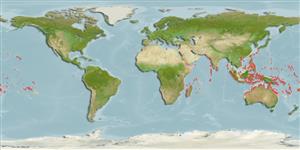Common names from other countries
Environment: milieu / climate zone / depth range / distribution range
Οικολογία
Υφαλόφιλο(α); εύρος βάθους 0 - 5 m (Ref. 96667). Tropical; 31°N - 28°S, 33°E - 134°W
Indo-Pacific, from Red Sea eastwards to Hawaii and French Polynesia.
Length at first maturity / Μέγεθος / Βάρος / Age
Maturity: Lm ? range ? - ? cm Max length : 15.0 cm CW αρσενικό/απροσδιόριστο; (Ref. 343)
Carapace ovate, surfaces smooth; 8 large teeth on each anterolateral margin (often with smaller denticles between them); front divided into 2 distinct lobes, separated by distinct V-shaped cleft. Carpus of cheliped with 2 spines on inner margin. Pincers are very large and unequal, the arm has 1 to 3 spines on the upper border (Ref. 128968). Color: red to reddish brown overall.
Adults are often found in shallow waters and coral reefs (Ref. 128968). Marginal levels of toxicity were detected in this species which may contribute to human poisoning (Ref. 107779). Occurs at intertidal reef areas. Benthic. Subtropical and tropical climates (Ref. 343). Mildly poisonous (Ref. 103037). Members of the family Xanthidae range from being algal scrapers to aggressive predators (Ref. 103027).
Life cycle and mating behavior
Γεννητική Ωρίμανση | Αναπαραγωγή | Γεννοβολία | Αβγά | Γονιμότητα | Προνύμφες
Members of the order Decapoda are mostly gonochoric. Mating behavior: Precopulatory courtship ritual is common (through olfactory and tactile cues); usually indirect sperm transfer.
Ng, P.K.L. 1998. (Ref. 343)
IUCN Red List Status (Ref. 130435)
CITES status (Ref. 108899)
Not Evaluated
Not Evaluated
Threat to humans
Poisonous to eat (Ref. 107779)
Human uses
αλιεία: Εμπορικό(ά)
| FishSource | Η θάλασσα γύρω μας
Εργαλεία
Περισσότερες πληροφορίες
Age/SizeΑύξησηLength-weightLength-lengthΜορφολογίαΠρονύμφεςΑφθονία
Διαδικτυακές πηγές
Estimates based on models
Preferred temperature
(Ref.
115969): 24.9 - 29.3, mean 28.2 (based on 2264 cells).
Vulnerability
Low vulnerability (10 of 100).
Price category
Unknown.
